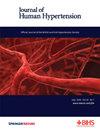单导联心电图在动脉高血压诊断中的诊断性能:一种机器学习方法。
IF 2.7
4区 医学
Q2 PERIPHERAL VASCULAR DISEASE
引用次数: 0
摘要
认识和早期识别高血压对减轻心血管疾病(CVD)的负担至关重要。基于人工智能的 12 导联心电图(ECG)分析已经可以检测出心律失常和高血压。我们进行了一项双中心观察研究,目的是开发一种机器学习算法,从单导联心电图中主动检测动脉高血压。这可以作为概念验证,着眼于当今记录单导联心电图的可穿戴设备。在一项前瞻性观察研究中,我们连续招募了 1254 名受试者(539 名男性,年龄为 60.22 ± 12.46 岁),他们患有或不患有本质性高血压,且无心血管疾病迹象。我们使用数字心电图仪对每位受试者在静息状态下进行了持续 10 秒的 12 导联心电图检查,并使用校准过的随机森林(RF)对 I 导联进行了分离分析。我们的 RF 模型能在保持不变的测试集中对高血压和正常血压受试者进行分类,准确率为 75%,ROC/AUC 为 0.831(95%CI:0.781-0.871),灵敏度为 72%,特异性为 82%(灵敏度和特异性以 0.675 为阈值计算)。年龄增大、体重指数值增大、T 波下面积除以 QRS 波群面积以及根据体重指数调整后的 QRS 波段下面积是我们的模型做出分类决定的四个最重要特征。这项研究证明了利用单导联心电图伺机检测未确诊的高血压的潜力。虽然还需要对可穿戴设备的数据进行研究,才能将我们的发现转化为实际的智能手表设置,但我们的研究结果可以为高血压认知的创新技术铺平道路。本文章由计算机程序翻译,如有差异,请以英文原文为准。

Diagnostic performance of single-lead electrocardiograms for arterial hypertension diagnosis: a machine learning approach
Awareness and early identification of hypertension is crucial in reducing the burden of cardiovascular disease (CVD). Artificial intelligence-based analysis of 12-lead electrocardiograms (ECGs) can already detect arrhythmias and hypertension. We performed an observational two-center study in order to develop a machine learning algorithm to proactively detect arterial hypertension from single-lead ECGs. This could serve as proof of concept with an eye towards todays wearables that record single-lead ECGs. In a prospective observational study, we enrolled 1254 consecutive subjects (539 male, aged 60.22 ± 12.46 years), with and without essential hypertension, and no indications of CVD. A 12-lead ECG of 10 seconds duration in resting position was performed on each subject using a digital electrocardiograph and lead I was isolated for analysis using a calibrated Random Forest (RF). Our RF model classified hypertensive from normotensive subjects on a hold-out test set, with 75% accuracy, ROC/AUC 0.831 (95%CI: 0.781-0.871), sensitivity 72%, and specificity 82% (sensitivity and specificity calculated using a threshold of 0.675). Increasing age, larger values of body mass index, the area under the T wave divided by the QRS complex area, and the area under QRS segment adjusted for BMI, were the four most important features that drove the classification decisions of our model. This study demonstrates the potential to opportunistically detect an undiagnosed hypertension, using a single-lead ECG. While studies with data from wearables are required to translate our findings to actual smartwatch settings, our results could pave the way to innovative technologies for hypertension awareness.
求助全文
通过发布文献求助,成功后即可免费获取论文全文。
去求助
来源期刊

Journal of Human Hypertension
医学-外周血管病
CiteScore
5.20
自引率
3.70%
发文量
126
审稿时长
6-12 weeks
期刊介绍:
Journal of Human Hypertension is published monthly and is of interest to health care professionals who deal with hypertension (specialists, internists, primary care physicians) and public health workers. We believe that our patients benefit from robust scientific data that are based on well conducted clinical trials. We also believe that basic sciences are the foundations on which we build our knowledge of clinical conditions and their management. Towards this end, although we are primarily a clinical based journal, we also welcome suitable basic sciences studies that promote our understanding of human hypertension.
The journal aims to perform the dual role of increasing knowledge in the field of high blood pressure as well as improving the standard of care of patients. The editors will consider for publication all suitable papers dealing directly or indirectly with clinical aspects of hypertension, including but not limited to epidemiology, pathophysiology, therapeutics and basic sciences involving human subjects or tissues. We also consider papers from all specialties such as ophthalmology, cardiology, nephrology, obstetrics and stroke medicine that deal with the various aspects of hypertension and its complications.
 求助内容:
求助内容: 应助结果提醒方式:
应助结果提醒方式:


